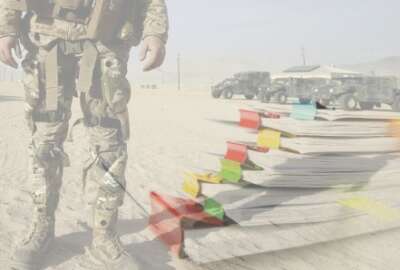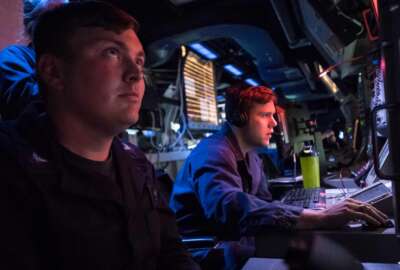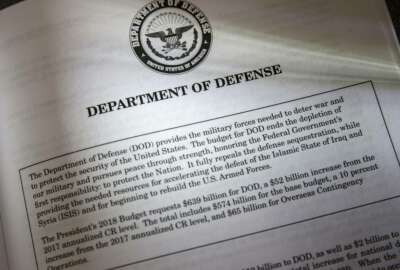
Navy seeing ‘explosion’ in use of OTA for IT, cyber development work
The Navy was a relative latecomer to other transaction agreements, but the service's usage of OTAs in the IT space has surged, and the service is moving prototypes...
The last several years of Defense spending have a seen a more than seven-fold increase in the amount of money being spent through other transaction agreements for technology development. And although the Navy has been a relative latecomer to OTAs compared to its sister services, the approach is taking off in a big way in the areas of information technology and cybersecurity.
In August, the Navy announced it was increasing the ceiling value for its Information Warfare Research Project OTA to $500 million after having exhausted its initial $100 million ceiling in just a little over a year-and-a-half. Meanwhile, last month, officials announced the project’s first three programs to have moved from prototypes to full-blown production systems.
“It’s been a very large success. We’ve been able to promote this, both internally and with our sponsors to identify requirements that fit our rapid prototyping construct, ultimately with the goal of getting things into the warfighters’ hands quicker than in other contract strategy approaches,” Kevin Charlow, the chairman of the IWRP Executive Steering Group and deputy executive director of Naval Information Warfare Center-Atlantic said in a recent interview for Federal News Network’s On DoD. “As we continue to identify new requirements and as the word gets out, and people get more comfortable using this type of vehicle, the available ceiling has been used up. So we’re pleased about that and we’re looking forward to the future.”
To move new technologies to the fleet via IWRP, the Navy is using a provision of DoD’s OTA authority, added in 2016, that lets the government make sole-source awards to the same vendor who conducted the prototype work, as long as the initial prototype was competitively awarded.
That was the case with the first three IWRP projects to move into the production phase. All three production agreements were awarded in the closing weeks of Fiscal 2020. They are:
- Low Altitude Range Communication System (LARCS), a project that aims to replace the Marine Corps’ air-to-ground radio systems with a voice-over-IP-based system.
- Analytic Performance Assessment Capability (APAC), a Navy-wide decision support tool that ties together historical data from various libraries with exercise and wargaming documentation, and applies artificial intelligence and machine learning tools to all of that data.
- Master Data Management (MDM), a new system the Navy developed in collaboration with the Defense Health Agency to connect various existing DoD health data repositories as the department continues to roll out its new electronic health record, MHS Genesis.
Another project on the near-term horizon for early 2021 is a system that could eventually automate many of the functions of the Navy Enterprise Service Desk — the Navy-wide helpdesk for IT problems.
Don Sallee, NIWC-Atlantic’s acquisition services manager, said the system aims to mirror some of the same technologies companies like Amazon and Google use when customers call their phone support lines.
“They’re using artificial intelligence and some predictive analytics so that a member calling in to get that tech support can actually, a lot of times, get a lot faster response to address their concerns or a technology challenge,” he said. “That helps reduce the total number of human touch point responses by the Navy Enterprise Service Desk. So you’re looking at efficiency, you’re looking at reduced resourcing requirements, which is going to result in cost savings for the Navy holistically.”
Like many other DoD OTAs, the Navy’s spending through IWRP is filtered through a nonprofit consortium. As a result, awards to individual companies are not reported in the Federal Procurement Data System, making it difficult for researchers, journalists and oversight bodies to assess whether the department is meeting Congress’s intent to use OTAs primarily as a way to attract “nontraditional” companies into the Defense contracting space.
But Sallee said internal data maintained by NIWC-Atlantic — which oversees the IWRP OTA — shows 75 percent of the companies in the consortium qualify as nontraditional companies, and 65 percent of the awards the Navy has made through the OTA so far have gone to nontraditional vendors.
“What’s even more impressive about that is for that remaining 35%, the company that got the award partnered with a non-traditional to perform a significant scope area of that prototype,” he said. “So when you really take a look at it, 65% of the prototypes awarded to date were primed to a non-traditional, and then we have non-traditional performers doing a significant scope on prototypes for that remaining 35% that was awarded to a more traditional defense partner.”
The recent ceiling increase also extends IWRP’s period of performance for another two years, extending the OTA through the summer of 2023.
“Based on the requirements from several sponsor areas, particularly in the 5G arena, we anticipate there’s a high probability that will use that ceiling up again in that two year period,” Charlow said.
Indeed, it’s almost certain to happen if the growth in use of the IWRP maintains its current trajectory. In 2020, NIWC-Atlantic forecast about $35 million in awards. Instead, it awarded about $100 million in that year alone, helped by the recent ceiling increase.
“It’s just a complete explosion in the usage of these prototyping capabilities, and it’s a great opportunity for the Navy to get that technology into the fleet faster,” Salee said.
Copyright © 2025 Federal News Network. All rights reserved. This website is not intended for users located within the European Economic Area.
Jared Serbu is deputy editor of Federal News Network and reports on the Defense Department’s contracting, legislative, workforce and IT issues.
Follow @jserbuWFED
Related Stories





